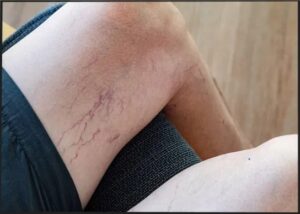Why Are Your Leg Veins Turning Purple? What It Could Mean and How to Respond

Purple or darkened veins on the legs are a fairly common sight, especially as people get older or spend much of their day sitting at a desk or standing on their feet. At first, these veins may simply change the way your legs look without causing much discomfort. But over time, they can be a signal of deeper health concerns that shouldn’t be ignored.
This guide breaks down the causes, warning signs, potential risks, and preventive measures you should know if you’ve noticed purple veins developing on your legs.
What Causes Purple Veins on the Legs?
Several different factors can lead to the appearance of purple or bulging veins:
-
Family history – Genetics are a strong contributor. If parents or grandparents had vein problems, the likelihood of developing them is much higher.
-
Sitting or standing for too long – Poor circulation from a sedentary lifestyle makes it easier for blood to pool in the lower body, straining the veins.
-
Excess body weight – Carrying extra pounds puts constant pressure on the legs and gradually weakens vein valves.
-
Age-related changes – As we age, blood vessels lose elasticity, making them more prone to damage and discoloration.
Could Purple Veins Signal an Underlying Condition?
In some cases, these veins are more than a cosmetic issue. They can point to medical problems such as:
-
Chronic venous insufficiency – Vein valves fail to work correctly, causing blood to flow backward and veins to enlarge.
-
Blocked arteries or vascular disease – Circulation problems can make veins more visible and discolored.
-
Previous leg injuries – Trauma or bruising can temporarily turn veins purple.
-
Heart-related issues – If vein changes come with chest pain or shortness of breath, it could be tied to cardiovascular disease.
-
Type 2 diabetes – This condition weakens blood vessels and can make vein changes more noticeable.
If untreated, purple veins may worsen and lead to complications like ulcers, phlebitis, or deep vein thrombosis—conditions that carry real health risks.
Early Signs to Watch For
Beginning Stage
-
Small bluish or purplish veins just beneath the skin
-
No pain at first—often spotted by others before you notice
-
Veins appear more visible after sitting or standing for long stretches
Advanced Stage
-
Veins become larger, raised, and darker in color
-
Legs feel heavy, achy, or swollen
-
Muscle cramps, burning sensations, or throbbing by the end of the day
-
Symptoms worsen with activity or long hours on your feet
How to Prevent and Manage Purple Veins
Lifestyle changes can go a long way in keeping your veins healthy:
-
Maintain a healthy weight – Less pressure on veins means better circulation.
-
Stay active – Walking, swimming, or cycling improves blood flow and strengthens muscles. Aim for at least 30 minutes a day.
-
Take breaks – If you sit or stand for long hours, shift positions and move around frequently.
-
Wear compression stockings – These gently squeeze the legs to help prevent blood from pooling.
-
Limit high heel use – Frequent wearing of heels increases strain on veins. Opt for supportive footwear when possible.
Final Takeaway
Purple veins in the legs might look harmless at first, but they can serve as an early warning sign of vein disease or circulation problems. If your veins are persistent, worsening, or accompanied by swelling, heaviness, or other troubling symptoms, it’s important to see a doctor rather than dismiss them as “just cosmetic.”
Early treatment not only improves comfort and appearance but also reduces the risk of serious complications. Taking care of your legs today can protect your overall health tomorrow.
Disclaimer: This article is intended for informational purposes only. It should not be taken as medical advice. Always consult with a healthcare professional before starting any treatment or lifestyle change.